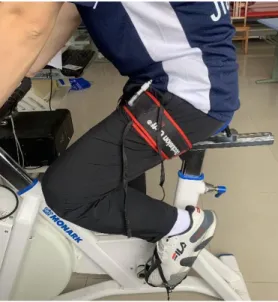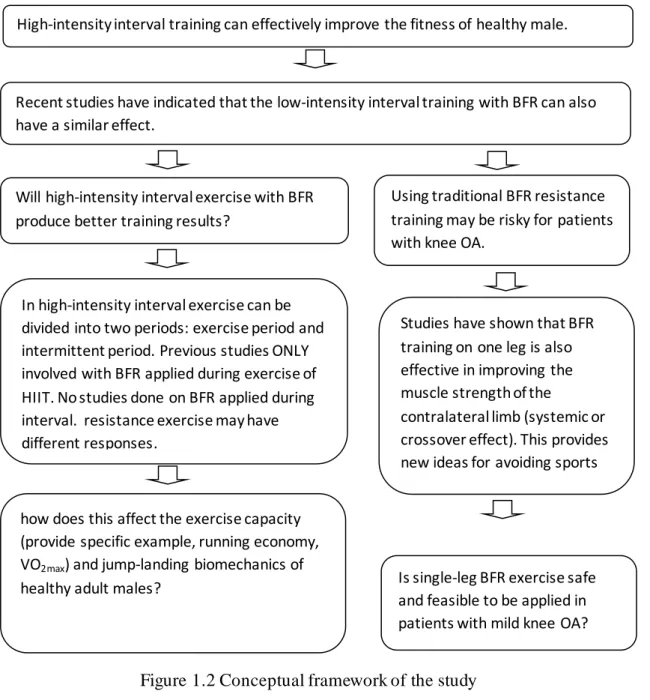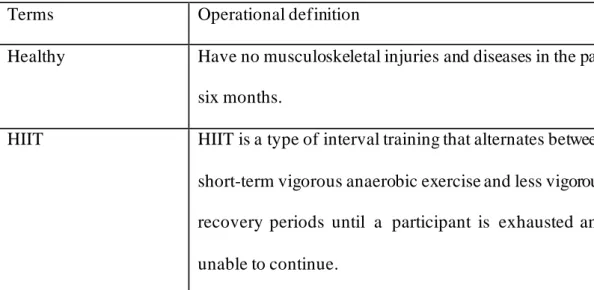Finally, I would like to thank everyone who helped me in any way throughout the research work. In addition, the application of BFR in the interval phase of HIIT improved cycling economy and fatigue index better than when BFR was applied during the exercise phase. For the OA patients, the perceived exertion (RPE) rating was higher after exercise with an elastic band with BFR.
Notably, elastic band exercise with BFR reduced gait symmetry in early walking stance.
Background of the study
Therefore, choosing a lower cuff pressure (eg, 40% LOP) may provide ischemic stimulation comparable to a higher pressure (80% LOP) but with greater comfort (Crossley et al., 2020). Interestingly, although the intensity of BFR exercise is very low, its effects on increasing muscle size and strength are similar to a typical high-intensity resistance exercise (Vechin et al., 2015). BFR intervention also improved aerobic capacity (Cook, Kilduff & Beaven, 2014; Oliveira et al., 2016; Lixandrão et al., 2018) similar to the effects of high-intensity interval training (HIIT) that improved aerobic and anaerobic capacity (Eddolls et al., 2017; Gomes-Neto et al., 2017).
Currently, only two studies have examined the effects of a combination of HIIT and BFR, finding that the BFR group showed better running economy and higher maximal running speed than the non-BFR group (Keramidas et al., 2012; Paton et al., 2017). . The phase of BFR use will determine the outcome, as Teixeira et al. (2018) observed increased blood lactate concentration during the interval phase than during the resistance exercise phase with BFR. Recently, low-intensity resistance training with BFR has been used as a rehabilitation tool for knee OA patients (Segal et al., 2015; Ferraz et al., 2018; Harper et al., 2019).
Reduction of muscle atrophy, improvement of muscle mass and strength, thereby increasing the stability of the knee joint, is the focus of knee OA rehabilitation (Harper et al., 2019). Therefore, low-intensity resistance exercise with BFR can increase muscle strength at lower pain scores (Hughes et al., 2017), indicating that it can be used as an alternative to high-intensity resistance training. However, previous studies of BFR use among patients with musculoskeletal injuries/problems focused on pain and physiological outcomes (Segal et al., 2015; Harper et al., 2019).
Problem statement
BFR applied in exercise versus interval phase may have different physiological and biomechanical effects (Teixeira et al., 2018). Teixeira et al., (2018) observed increased blood lactate concentration during the interval phase as the exercise phase of resistance exercise with BFR. However, no studies have compared the effects of different phases of application of BFR during HIIT.
But is this intervention safe to be applied in patients with knee OA, still remains unanswered. This is because patients with knee osteoarthritis are more vulnerable than healthy adults, and its safety in healthy adults needs to be determined. Low-intensity training with BFR increased muscle strength among patients with knee pain (Li, Shaharudin & Abdul Kadir showed that BFR training on one leg improved the contralateral limb's muscle strength, known as the cross effect.
This result provides new ideas for using unilegal exercises for patients with knee osteoarthritis to avoid straining the affected leg during exercise rehabilitation. However, to our knowledge, the biomechanical effects of BFR in patients, especially those with knee osteoarthritis, are not known. Therefore, this study aims to investigate the immediate effects of elastic band resistance exercise with BFR on lower limb biomechanics and the feasibility of using BFR in patients with unilateral knee osteoarthritis.
Research objectives
Blood flow restriction can cause greater muscle fatigue after exercise (de .. Queiros et al., 2021), which can affect the biomechanical performance. To compare the immediate effects (pre- and post-exercise time points x two groups) of elastic band resistance exercise with and without BFR on pain, RPE and blood pressure responses among patients with mild knee OA. To compare the immediate effects (pre- and post-exercise time points x two groups) of elastic band resistance exercise with and without BFR on lower limb biomechanics during gait and STS among patients with mild knee OA.
Statistical hypothesis
HA: After 12 weeks of intervention, there are significant differences in aerobic capacity, anaerobic capacity, knee strength, cycling economy, and lower limb biomechanics during single-leg landing between high-intensity interval training with BFR during exercise versus during the interval in healthy adult males. Statistical hypotheses for the second part are: .. a) HO: There are no significant differences in the acute RPE, pain and blood pressure responses after elastic band resistance exercises with BFR in patients with mild knee osteoarthritis. There are significant differences in the acute RPE, pain, and blood pressure responses after elastic band resistance exercise with BFR in patients with mild osteoarthritis of the knee. b) HO: There are no significant differences in lower limb biomechanics during gait and STS after elastic band resistance exercise with BFR in patients with mild knee OA.
HA: There are significant differences in lower limb biomechanics during walking and STS function effects after elastic band resistance exercise with BFR among patients with mild knee OA.
Significance of the study
These research results will enable us to understand the effects of long-term BFR interventions during different HIIT phases. We expect to prescribe more targeted exercises that can improve physiological and biomechanical performance. The second part investigated the immediate effects of elastic band resistance training with BFR on pain, functional and biomechanical variables in female patients with mild knee OA.
We aimed to find a safer and more effective non-pharmaceutical intervention for patients with mild knee OA. Therefore, the overall aspect of the BFR application is examined, namely type of training, gender, age and unilateral or bilateral limb exercise in the current work.
Operational definition
Mild knee OA Diagnosed with mild knee OA using the Kellgren-Lawrence Severity Scale and knee pain ≥ two on a visual analogue scale (VAS) in the past week. At the same time the patient has no other medical problems such as diabetes and peripheral vascular disease. Physically active Participate in a sport-specific training program at least three times per week and total score more than 600MET-min/week based on the International Physical Activity Questionnaire (IPAQ).
Blood flow restriction training
Mechanism of blood flow restriction
Due to the significant accumulation of metabolites during exercise with limited blood flow (Kraemer et al., 2017), the oxygen content of the internal environment is reduced. The pituitary gland is stimulated to release growth hormone (GH) by the chemosensory reflex of afferent nerves in groups III and IV (Gosselink et al., 1998). Takarada et al., (2000) found that after knee extension exercise with 20% of 1-Repetition Maximum (1-RM) BFR, the GH concentration increased significantly to 290 times that of rest.
On the contrary, Mitchell et al., (2013) showed that after BFR exercise, the GH concentration, IGF-1 and testosterone did not change, and the increase in IGF-1 concentration was not caused by GH secretion . Mammalian Target of Rapamycin (mTOR) is considered the primary network regulating skeletal muscle growth (Bodine et al., 2001) and may participate in the regulation of mRNA translation and protein synthesis (Wang & Proud, 2006). During exercise, protein kinase B is activated by IGF-1 to induce mTOR to stimulate protein translation and further promote muscle growth (Bodine et al., 2001).
Also, heat shock protein (HSP), as a molecular chaperone under normal conditions, helps protein aggregation and transport (Kiang, 1998) and plays an important role in maintaining cellular homeostasis (Simar et al., 2007). Laurentino et al., (2012) divided 29 young male subjects into the low-intensity BFR training group (BFR group) with 20% 1-RM, the high-intensity training group with 80%. Early research has shown that the high-threshold motor unit correlates with strength, muscle contraction speed, and oxygen concentration during exercise (Moritani et al., 1992).
Application of blood flow restriction
The prevalence rate of knee OA in Southeast Asia is comparable to Caucasian and Japanese populations (Muraki et al., 2009; Nguyen et al., 2011). The prevalence of radiographic knee OA in Southeast Asia is about 35% and 31% in women and men, respectively (Fransen et al., 2011). The Global Burden of Disease Study shows that osteoarthritis of the knee is one of the fastest growing orthopedic surgical diseases and ranks second among causes of disability worldwide (Cross et al., 2014).
However, high-intensity strength training among rehabilitating populations with musculoskeletal injuries is challenging due to deterioration of limb function, pain and risk of injury (Hoyt et al., 2015). Limb occlusion pressure (LOP) of 70% was used in BFR training to limit blood flow in patients with knee OA (Ferraz et al., 2018). Interestingly, BFR training can also reduce joint pressure, which further reduces pain, thus becoming a potential adjunctive rehabilitation method for OA treatment (Ferraz et al., 2018; Li, Shaharudin. & Abdul Kadir, 2021).
It is impossible to place BFR in the injured leg with OA and knee pain (Harper et al., 2019). Fortunately, one study (Bowman et al., 2019) has shown that BFR training in one leg effectively improves muscle strength of the contralateral limb (ie, systemic or crossover effect). It is speculated that this may be due to a greater metabolic stress caused by blood flow restriction resulting in an increase in systemic circulating hormones associated with myogenesis, which in turn benefits the contralateral limb (Bowman et al. , 2019).
Methodological issues of blood flow restriction training (a) Types of blood flow restricted devices (a) Types of blood flow restricted devices
The same acute response can be observed during BFR exercise using elastic or nylon inflatable cuffs of the same width and pressure (Dankel et al., 2017). The restriction of blood flow usually affects the muscle groups around the cuff (Bowman et al., 2019). BFR pressure will vary due to differences in cuff width (Crenshaw et al., 1988) and individual characteristics such as limb girth (Jeremy et al., 2012).
A study using elastic bandages uses perceived pressure to quantify the pressure of BFR because external pressure cannot be quantified (Wilson et al., 2013). There is also a study using arterial blood flow measurements to quantify the BFR pressure (Laurentino et al., 2008). For example, a level 7 out of 10 subjective pressure without discomfort and pain can be used as a standard for BFR training (Wilson et al., 2013).
A follow-up study showed that this method improved muscle mass and strength (Salyers et al., 2018). When applying a blood flow restriction, the cuff pressure must therefore be set accordingly. It should be noted that the initial pressure (i.e., the cuff pressure on the limb) will have some effect on BFR (Karabulut et al., 2011). Given the discomfort caused by increased pressure, the recommended cuff pressure is 40% LOP (Crossley et al., 2020).


